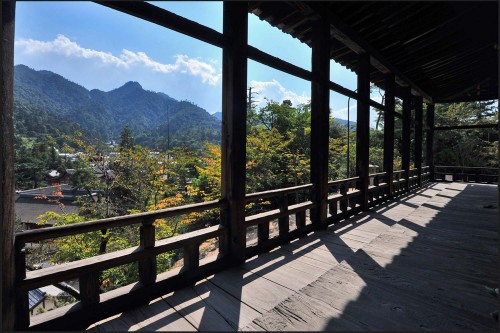I like to include in a post a photo and question from one of the photographers that follow my blog.
Here’s one from a photographer in Japan, and as usual, I like to show the note that he sent because I find that there are lots of photographers out there that have had similar problems with similar questions on how to fix those problems. Here’s what he had to say:
“Hi Joe,
I am posting a photograph that has to do with lines. This is a photo on the outer part of a temple in Japan. What i want to know is if there are horizontal and vertical lines in one scene, which one takes priority over the other? In this photo, I used the vertical line closest to the left side, but the distortion is still present. It seemed the wooden structure is falling/leaning over to the mountain side. I tried to correct the distortion but in the end, I am still unsure what is the correct way to see. Lens used was the 16-35mm”.
Thank you,
I tell my online students with the BPSOP, and in my “Stretching Your Frame of Mind Workshops” I conduct, Line is the most important of all the elements of visual design, for without Line none of the other elements could exist. The basic elements of design such as Pattern, Texture, Shape, Form, etc. all need Line to be what they are. In fact, you and I would not exist nor would planes, trains and automobiles because we all have an outLine.
Having said that, the most important Line is the horizon line. That’s the first Line you should correct. Since I almost always shoot on a tripod, the very first thing I do is to make sure my horizon line is straight. The only time it might not be straight is if you saw it from the Space Shuttle. FYI, the “unmentionable” word around the teaching scene is that when you see a photo with a horizon line that’s not straight, it’s a sure sign that a novice took the photo…I’m just saying!!!
Once you have the horizon line straight, then you look at the other horizontal lines and the vertical lines. Never try to correct those lines beforehand since by doing so, you might render the horizon as being off-kilter. If the vertical and other horizontal lines are not correct, then leave them because something made them the way they are. For example the wind, a storm, the ground shifting, bad construction, or just plain old ‘Father Time”. As I said, the horizon line is always going to be straight…no matter what. If you wake up one day and the horizon line is not straight, it would be a good time to pay back any past debts you might owe friends because you won’t have any more use for money!!!
Now that the horizon line has been taken care of, I look for the dominant line, whether it be a vertical or a horizontal. If the vertical lines are close to the edge of the frame, I always straighten them since they are more susceptible to bend; this is especially true if you have a wide angle lens on like your 16-35mm. The wider the lens, the harder it is to use as far as making your lines straight. The wider the lens, the more curve there is in your glass which curves the lines. The key is to always tr to have your camera level.
Correcting the horizontal lines is a matter of tilting your camera to the left or right.To correct the vertical lines you simply tilt the camera up or down. Tilting the camera up and the lines go in and when you tilt your camera down, the lines go out. In the photo you posted, if you would have tilted the camera down (just a touch) you would have corrected the vertical lines WITHOUT affecting any of the horizontal lines. That is once you have the horizon straight.
Hope this helped!!!
Visit my website at: www.joebaraban.com, and follow me on Instagram: www.instagram.com/barabanjoe take a look at my workshop schedule at the top of this blog. Come shoot with me sometime.
JoeB






Joe,
That was a big chunk of advice on lines. Thank you very much for this.
Regards,
Lemena Halim
You’re welcome.
JoeB